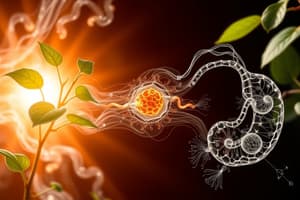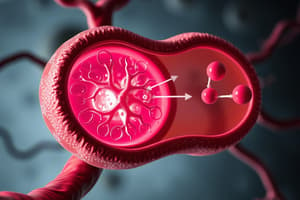Podcast
Questions and Answers
Which form of vitamin B6 is predominantly found in plant materials?
Which form of vitamin B6 is predominantly found in plant materials?
- Vitamin B5
- Pyridoxal
- Pyridoxamine
- Pyridoxine (correct)
What is one of the primary uses of vitamin B6?
What is one of the primary uses of vitamin B6?
- Boosting muscle mass
- Improving mood (correct)
- Enhancing vision
- Increasing bone density
Which of the following is a symptom of vitamin B6 deficiency?
Which of the following is a symptom of vitamin B6 deficiency?
- Excessive sweating
- Peripheral neuropathy (correct)
- Weight gain
- Vision impairment
Which of the following foods is not a good source of vitamin B6?
Which of the following foods is not a good source of vitamin B6?
What role does vitamin B6 play in the body?
What role does vitamin B6 play in the body?
Which of the following foods is most likely to provide a high source of vitamin B7?
Which of the following foods is most likely to provide a high source of vitamin B7?
What is the primary metabolic role of vitamin B7?
What is the primary metabolic role of vitamin B7?
Which symptom is most likely associated with a deficiency of vitamin B7?
Which symptom is most likely associated with a deficiency of vitamin B7?
Vitamin B9 is crucial for which aspect of health?
Vitamin B9 is crucial for which aspect of health?
Which of the following is a rich source of vitamin B9?
Which of the following is a rich source of vitamin B9?
What is the primary function of folate in the body?
What is the primary function of folate in the body?
Which vegetables are mentioned as a source of vitamin B7?
Which vegetables are mentioned as a source of vitamin B7?
What can be a result of vitamin B7 deficiency?
What can be a result of vitamin B7 deficiency?
Which enzyme catalyzes the reaction between CO2 and ribulose-1,5-bisphosphate (RuBP)?
Which enzyme catalyzes the reaction between CO2 and ribulose-1,5-bisphosphate (RuBP)?
What is the main product formed from the reduction of 3-phosphoglyceric acid (3-PGA)?
What is the main product formed from the reduction of 3-phosphoglyceric acid (3-PGA)?
During glycolysis, which of the following substances is produced?
During glycolysis, which of the following substances is produced?
What is required for the regeneration of ribulose-1,5-bisphosphate (RuBP)?
What is required for the regeneration of ribulose-1,5-bisphosphate (RuBP)?
Which building block is derived from L-methionine?
Which building block is derived from L-methionine?
What occurs during the Krebs cycle?
What occurs during the Krebs cycle?
How many ATP molecules are generated from one molecule of glucose during glycolysis?
How many ATP molecules are generated from one molecule of glucose during glycolysis?
What are the substrates that drive the shikimic acid pathway?
What are the substrates that drive the shikimic acid pathway?
Which of the following intermediates is crucial for biosynthesis from primary metabolites?
Which of the following intermediates is crucial for biosynthesis from primary metabolites?
What type of compounds does the shikimic acid pathway primarily biosynthesize?
What type of compounds does the shikimic acid pathway primarily biosynthesize?
Which aromatic amino acids are synthesized through the chorismate pathway?
Which aromatic amino acids are synthesized through the chorismate pathway?
Which of the following is NOT an environmental trigger for the expression of aromatic compounds?
Which of the following is NOT an environmental trigger for the expression of aromatic compounds?
What is one of the main consequences of vitamin B deficiency?
What is one of the main consequences of vitamin B deficiency?
Which enzyme catalyzes the reaction to form 5-enolpyruvylshikimate-3-phosphate?
Which enzyme catalyzes the reaction to form 5-enolpyruvylshikimate-3-phosphate?
What is the overall reaction formula for the metabolization of glucose in the presence of ADP and inorganic phosphate?
What is the overall reaction formula for the metabolization of glucose in the presence of ADP and inorganic phosphate?
Which of the following types of organisms utilizes the shikimate pathway?
Which of the following types of organisms utilizes the shikimate pathway?
What is the end product of the shikimic acid pathway?
What is the end product of the shikimic acid pathway?
Which vitamin is crucial for preventing scurvy?
Which vitamin is crucial for preventing scurvy?
Which of the following is a good dietary source of vitamin C?
Which of the following is a good dietary source of vitamin C?
What effect does cooking have on the vitamin C content in foods?
What effect does cooking have on the vitamin C content in foods?
Which property of vitamin C is highlighted as one of its important functions?
Which property of vitamin C is highlighted as one of its important functions?
What role does vitamin C play related to iron?
What role does vitamin C play related to iron?
What is an important function of vitamin C in the body?
What is an important function of vitamin C in the body?
Which of the following symptoms is associated with vitamin B deficiency?
Which of the following symptoms is associated with vitamin B deficiency?
Study Notes
Carbon Dioxide Fixation
- CO2 combines with RuBP (ribuose-1,5-bisphosphate) to form a six-carbon compound.
- This compound is unstable and splits into two molecules of 3-phosphoglyceric acid (3-PGA).
- This reaction is catalyzed by the enzyme RuBP carboxylase/oxygenase, or rubisco.
Reduction in Photosynthesis
- ATP and NADPH are used to convert 3-PGA molecules into G3P (glyceraldehyde-3-phosphate)
- NADPH donates electrons to a three-carbon intermediate to make G3P.
Regeneration in Photosynthesis
- Some G3P molecules are used to make glucose.
- Other G3P molecules are recycled to regenerate RuBP.
- This requires ATP and a complex network of reactions.
Glycolysis
- Converts glucose into pyruvate
- Occurs in the cytosol, independent of oxygen
- Generates a net gain of two ATP molecules
Citric Acid Cycle
- Occurs in the mitochondrial matrix under aerobic conditions.
- Oxidizes acetyl-CoA into CO2.
- Reduces coenzymes which generate ATP via the electron transport chain.
- Consists of eight enzymatic steps in the citric acid cycle.
- Overall reaction equation: C6H12O6 + 6CO2 + 38 ADP + 38P (inorganic) → 6H2O + 6CO2 + 38 ATP
Biosynthesis Pathway of Secondary Metabolites
- A multi-step, enzyme-catalyzed process that converts substrates into more complex products.
- Simple compounds are modified, converted, or joined to form macromolecules.
- Often consists of metabolic pathways with building blocks from primary metabolites like acetyl CoA, shikimic acid, mevalonic acid, and malonic acid.
Building Blocks in Biosynthesis
- C1 derived from S-methyl of L-methionine
- C derived from acetyl-CoA
- C5 derived from isoprene units
- C6-C3 units (phenyl propyl units) are derived from phenylalanine or tyrosine through the shikimic acid pathway.
Shikimic-acid Pathway
- Basic process for biosynthesis of phenolic compounds, alkaloids, and others.
- Occurs in plant chloroplasts.
- Triggered by environmental stresses like pathogens, herbivores, pH, temperature, UV radiation, salinity, and heavy metals.
- Used by bacteria, archaea, fungi, algae, some protozoans, and plants for the biosynthesis of folates and aromatic amino acids (phenylalanine, tyrosine, and tryptophan).
Chorismate Pathway
- Starts with phosphoenol pyruvate and erythrose-4-phosphate and ends with chorismate.
- Enzyme DAHP synthase catalyzes the reaction between phosphoenol pyruvate and erythrose-4-phosphate to form 3-deoxy-D-arabino- heptulosonate 7-phosphate.
- Shikimate kinase catalyzes the phosphorylation of shikimate to form shikimate 3-phosphate.
- 5-enolpyruvylshikimate-3-phosphate synthase (EPSP) synthase catalyzes the coupling of shikimate-3-phosphate with phosphoenol pyruvate to give 5-enolpyruvylshikimate-3-phosphate.
- Chorismate synthase transforms 5-enolpyruvylshikimate-3-phosphate into chorismate.
Vitamin B6 Sources
- Beef liver, tuna, salmon, fortified cereals, chickpeas, poultry, dark leafy greens, pineapple, papaya, oranges, and cantaloupe.
Vitamin B6 Uses
- Improves mood.
- Required for biological reactions like amino acid metabolism, neurotransmitter synthesis, and red blood cell formation.
- A co-factor for biochemical reactions regulating cellular metabolism.
Vitamin B6 Deficiency
- Can cause peripheral neuropathy, neurology abnormalities, skin lesions, and hypochromic microcytic anemia.
Vitamin B7 (Biotin) Sources
- Eggs, fish, meat, seeds, nuts, and vegetables like sweet potatoes.
Vitamin B7 (Biotin) Uses
- Plays a crucial role in metabolism as a coenzyme that transfers carbon dioxide.
- Involved in the breakdown of carbohydrates, fats, and proteins into energy.
- Involved in many cellular reactions, particularly in fat and protein metabolism of hair roots, fingernails, and skin.
- Used in fatty acid synthesis.
Vitamin B7 (Biotin) Deficiency
- Can cause fatigue, depression, and dermatitis.
Vitamin B9 (Folate) Sources
- Beans, peanuts, sunflower seeds, fresh fruits, fruit juices, whole grains, and liver.
Vitamin B9 (Folate) Uses
- Essential for brain development and function.
- Helps in brain function and synthesis of red blood cells.
Vitamin B9 (Folate) Deficiency
- Can involve rapidly dividing cells of the hematopoietic system (e.g., megaloblastic anemia) and irreversible neurologic damage (e.g., defective myelin nerve sheaths).
- Symptoms include irritability, weakness, memory loss, mood swings, and tingling/numbness of limbs.
Vitamin C Sources
- Citrus fruits, tomatoes, strawberries, and other fresh fruits and vegetables.
Vitamin C Uses
- Antioxidant activity.
- Functions in enzyme activation and oxidative stress reduction.
- Roles in collagen synthesis and iron absorption.
- Defense against infections and inflammation.
Studying That Suits You
Use AI to generate personalized quizzes and flashcards to suit your learning preferences.
Related Documents
Description
This quiz covers key processes in photosynthesis, including carbon dioxide fixation, reduction phase, and regeneration, as well as glycolysis and the citric acid cycle. Test your understanding of how these metabolic pathways function and their roles in energy production. Perfect for biology students!




